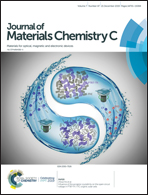Non-halogenated solution-processed ambipolar plastic transistors based on conjugated polymers prepared by asymmetric donor engineering†
Abstract
In addition to attaining strong charge transport capability, field-effect transistors based on conjugated polymer thin films should be processed using non-chlorinated solvents for device fabrication, to avoid adverse impacts on human health and the environment. Although many high-performance diketopyrrolopyrrole (DPP) based conjugated polymers have been studied, few DPP based polymers that can be processed in non-chlorinated solvents have been reported to date. In this work, ambipolar polymeric semiconductors based on a DPP backbone that can be solution-processed using non-chlorinated solvents are reported. The DPP backbone combined with asymmetric conjugated segments results in high solubility and processability in non-chlorinated solvents, such as toluene and o-xylene, without disruption in the conjugation and molecular ordering of the main backbone. The polymer films fabricated with a high-boiling-point additive show ambipolar charge transport characteristics and highly enhanced electrical performance due to greatly enhanced intermolecular interactions and the resulting aggregated nanostructures. The combination of non-chlorinated solution processing with the green additive, along with ambipolar characteristics, enables high-performance environmentally friendly complementary logic circuit integration to be achieved.



 Please wait while we load your content...
Please wait while we load your content...